Indiana Jones and the Kingdom of the Crystal Skull (2008, Dir. Steven Spielberg)It's not the years honey, it's the mileage.So said Indiana Jones (Harrison Ford) back in 1981, in
Raiders of the Lost Ark, and 27 years on, those words take on an additional poignance. Now it's about the years
and the mileage, as the 65-year old Ford and weathered filmmakers Steven Spielberg and George Lucas release the fourth chapter of the Jones saga. As Spielberg has said, there was never a pressing need to make this film -- the third film,
Indiana Jones and the Last Crusade (1989)
, concluded with Indy and his tetchy father, Henry Jones Sr. (Sean Connery) literally riding into the sunset, and in the protracted hiatus since then, rumors and ideas for a new adventure floated about much like the crazed spirits that were released from the Ark of the Convenant in
Raiders. No, claimed Spielberg, this film wasn't necessary, but it would be a valentine to the fans, a salute to their devotion to their pulp hero over the years.
Raiders still towers over the genre as its own unique creation -- unashamedly inspired by the pulp serials of Lucas and Spielberg's youth, it upped the ante with A-class production values, a knowing sense of humor, and action sequences that were fleet-footed and bone-jarring.
Raiders' lesser sequels
Indiana Jones and the Temple of Doom (1984) and the
Last Crusade tended to lean towards cartoonish bombast, but the die had been cast: these films set the template for action extravaganzas of the '80s and '90s, and their influence can be seen everywhere, from the increased action quota in the recent Bond films to the
Da Vinci Code and the tongue-in-cheek "hunting for buried artifact" hijinks of
Sahara and
National Treasure.
Indiana Jones and the Kingdom of the Crystal Skull is a conscious throwback to those halcyon '80s days, right down to the old-style Paramount logo that opens up the picture. Like the Bond series, Indy subsists on familiar signposts -- the beat-up fedora hat, the dusty booby-trapped tomb, Indy's phobia of snakes, the scenes of old-style planes buzzing towards far-off destinations that are helpfully outlined on a map, a familiar face or two for extra comfort. This time around we're in the year 1957, nearly 20 years after the last adventure: Indy is put on a trail that leads to a rumored lost city of gold in the heart of the Amazon when the young, well-coiffured Mutt Williams (Shia LeBouf) shows up on his university doorstep with a tale of a lost, mad professor (John Hurt) and a cadre of Soviet spies on his tail. This comes after a prologue in which Jones is kidnapped by the same Russkies, escorted to Area 51, where all of this country's secret artifacts (including the Ark of the Covenant, nudge nudge, wink wink) are squirreled away, and asked to locate a magnetic coffin containing the skeleton of what appears to be an alien (close encounters of the third kind, indeed). Leading the Commies is special agent Irina Spalko (Cate Blanchett), Stalin's golden girl and a self-proclaimed psychic expert eager to claim the all-seeing knowledge of the aliens for Mother Russia. Working with Spalko (or against her, depending on whim) is Cockney mercenary Mac (Ray Winstone), whose money hunger knows no bounds.
 |
Naturally, not all is as it seems, and plenty of twists and turns crop up before Indy and friends arrive at the fabled city. It's no big secret that Mutt is the lad Indy sired with Marion Ravenwood (Karen Allen), the feisty heroine of
Raiders, and most of the fun of the movie's first half comes from Indy and Mutt's guarded interactions. The older man is bemused at the younger man's incredulousness at his exploits; the younger man has a chip on his shoulder and a way with a switchblade, when he's not making like James Dean on the back of his motorbike and saving Indy during a fun motorbike chase across Yale University's grounds. Soon we're off to the Nazca lines in Peru, and then to the heart of South America's jungles, where the principals take turns betraying each other and stealing the titular crystal skull, which holds the key to the lost city.
For a while
Kingdom of the Crystal Skull is genial entertainment, preferring to lay back and lay on the exposition while pep is added with a few nifty action sequences. Certainly it approximates the look and feel of your standard lavish Indy adventure, as cinematographer Janusz Kaminski deliberately echoes the great Douglas Slocombe's rich palette from the '80s films. The movie's major setpiece, a motorcade chase in the jungle in which the antagonists find themselves playing musical jeeps, has a sprightly momentum when it's not cutting away to the sight of Mutt making like Tarzan with a multitude of CGI monkeys.
Yes, CGI -- before too long it becomes apparent that
Kingdom is crammed wall-to-wall with it, from imagined exotic locales, computer-generated groundhogs and killer ants, and a finale featuring a collapsing city that might as well be a bunch of floating pixels. The earlier Indy adventures didn't shy away from effects, or even dodgy ones, but the settings and practical stunts maintained an earthbound quality to them -- here, your eyes are apt to glaze over when you see two combatants clash swords as they stand on separate jeeps zooming at 60 miles per hour in a green-screened jungle. The concept is good in theory, but the artificiality of the effects blands out the edge.
While Spielberg's reflexes as an action filmmaker are still very much present, these movies require more than muscle memory -- they depend on zip, economy, and a devil-may-care brio. Tons of things are explained in
Kingdom, plenty of confrontations occur, and John Williams throws in some familiar musical motifs in an effort to get the blood flowing, and yet the movie lacks urgency, and a reason to care. Scene after scene wafts by, and historical explanations and mumbo-jumbo over clues and locations pile up. A Spielberg in his salad days would no doubt push pedal to the metal in order to get to the good stuff, and he might have had the room to do so if it wasn't for Lucas (who came up with the basic story with Jeff Nathanson). It's clear Lucas hasn't shaken off the over-talkiness from his Star Wars prequels, and the result is a protracted, distracted plot. Character interactions suffer the most with this approach: Marion and Indy trade a few zingers, yet their rekindled love receives a grand total of about 30 seconds on screen, while Indy and Mutt's easy chemistry tends to get lost amid the dusty caverns, trap doors and collapsing structures that seem to occupy every inch of the frame during the story's latter half. Her face jutting out from beneath a black bob cut and dressed in fatigues that would seem more suited for a plane mechanic, Blanchett is cartoonish yet alluring as Spalko; it's a shame her character isn't allowed to develop into a true threat. Old pros Hurt and Winstone are basically relegated to the scenery. Ford slips into the role of Indy like a weatherbeaten pair of slippers, and for a 65-year old he shows admirable energy and physical grace. Still, there is a touch of dullness in his performance, as if he (like Spielberg and Lucas) is shaking off the cobwebs even as he tries to pull the old moves.
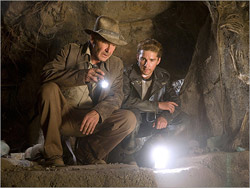 |
For all its subplots and hinted-at themes (how to age gracefully, the pursuit of knowledge for power),
Kingdom lacks the unity of the previous Jones adventures, hoary as they sometimes were. In
Raiders, the overriding idea was that some things are not meant to be known, even as it celebrated the derring-do that goes into the quest. The darker
Temple of Doom was a parable about Bogart-like nobility in the face of despicable subjugation, while the more family-oriented
Last Crusade suggested that family bonds are way more important than archeological glory or even immortality. Spielberg's values have always been conservative; in the end, new-fangled gadgetry and obsessive quests for the ultimate in power or knowledge take a back seat to home, hearth, and old-fashioned American home life, whether that home is a staid university classroom or the wedding inside a blindingly white church that occurs at the end of
Kingdom. But apart from that sweet conclusion (and a final sly shot of Mutt, or should we say Henry Jones III, holding Indy's fabled fedora in his hands, a faraway look in his eyes), you'll find little that's actually transporting. If
Raiders was a race car ride through the desert, sand and wind flying in your face, then
Kingdom is a meandering bus tour complete with jokey tour guide: you may look fondly upon the land as it passes by, note spots which seem mighty familiar, and remember when it was all fresh and new, when we all had a little less mileage on us.
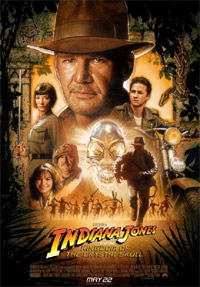
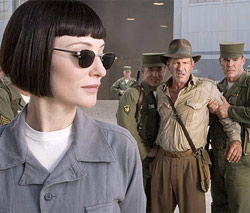

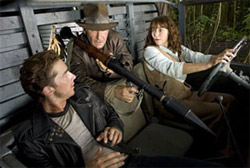
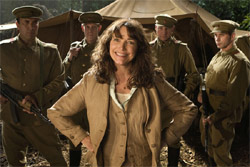



1 Comments:
I like your short and quick review its really nice and I hope you will continued this kind of blog which impressed us make the answers of queries I also like this film it good and In this is looking very powerful and brave heart, I really like his dressing sense he is looking handsome and attractive I Indiana Jones (Harrison Ford) Leather Jacket never forget this man
Post a Comment
<< Home